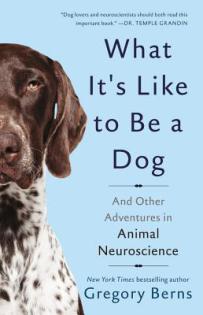
Published by Basic Books

Synopsis:
Does your dog really love you? Neuroscientist Gregory Berns used an MRI machine to find out.
What is it like to be a dog? A bat? Or a dolphin? To find out, neuroscientist Gregory Berns and his team began with a radical step: they taught dogs to go into an MRI scanner–completely awake. They discovered what makes dogs individuals with varying capacities for self-control, different value systems, and a complex understanding of human speech. And dogs were just the beginning. In What It’s Like to Be a Dog, Berns explores the fascinating inner lives of wild animals from dolphins and sea lions to the extinct Tasmanian tiger. Much as Silent Spring transformed how we thought about the environment, so What It’s Like to Be a Dog will fundamentally reshape how we think about–and treat–animals. Groundbreaking and deeply humane, it is essential reading for animal lovers of all stripes.
The principle of the book is ‘is it possible to understand the experiences of another species by scanning their brains?’. The result is an overwhelming ‘sort of’. Neuroscience is still a pretty young area of science and technology is starting to catch up with the questions we have about animal consciousness and experience – this is a field to keep an eye on if you’re interested in animal behaviour and neuroscience. Berns and his team study self-determination, logic and self discipline in dogs, along with other characteristics usually only accepted in humans.
Science aside, my favourite parts of this book were the occasional photos of labradors in fMRI scanners – is there anything cuter than a retriever wearing earmuffs? (Hint: No. No there is not).

In regards to the dogs, the sample sizes are still small and I wonder how representative they are of the species as a whole as it takes a certain kind of dog to sit still in an MRI machine for long enough to get coherent readings… what does the brain of a ratbag of a dog look like?
The book also covers some really interesting areas, such as naturally occurring poisoning in sea lions (for once, it’s not us poisoning the water!) and the effect it has on their brain and also the value of scanning the brains of other species.
The writing style is excellent, there’s a great deal of detail about the scientific processes and experiments involved which I found fascinating but the narrative is entertaining enough to be an enjoyable read rather than just straight up science. I found this book to be an interesting introduction to a wider subject, but I don’t feel that it really reached many conclusions, raising more questions than it was able to answer at this point in time.
Here’s hoping for a sequel in 10 years time!
*Thank you Netgalley for a free copy of this book in exchange for an honest review*
Share this:




